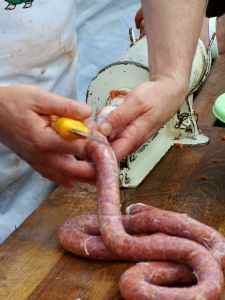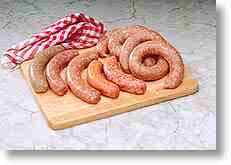Sausage Casings
Sausage casings are what you stuff your ground and seasoned meat into. Almost every sausage recipe calls for a casing of some kind.

There's more than one kind and size to choose from...
...what you use will depend on personal taste and the recipe you are making.
I used to be able to find natural varieties at my local market, but that was many years ago.
Now, unless you're lucky enough to live in a town with a sausage supply house, you're probably going to have to order them through the mail.
Natural Casing
This is the original (and still the most popular). It's made from the intestines of hogs, sheep, and cattle.
Hog casing is the most commonly used natural variety. If you've ever eaten a Polish or Italian sausage link, you've almost certainly eaten this kind.
They come in different sizes, from around 1 1/8 to about 2 inches in diameter. The recipe you are following will usually tell you the best size to use.

Sheep casings (sometimes called "lamb") are smaller in diameter than those made from hog intestines, from 3/4 to slightly over an inch. These are commonly used for smaller sausages like breakfast links.
I use the larger ones to make kosher sausage links when I can't find beef rounds that are small enough.
Beef Casings are the largest, and are normally used for things like summer sausage, ring bologna, and cappicola. The biggest size (called bungs) were traditionally used for large bologna.
These are either called rounds (taken from the small intestine), middles (from the large intestine) or bungs (taken from the section connecting the large and small intestines). Beef sausage casings tend to have a slightly more intense aroma than those from hogs and sheep.
The natural casings I buy and use in my own sausage making are packed either in dry salt or brine, and they're sold by diameter and length.
Most places that sell casings will tell you how many pounds of sausage a particular order (length) will stuff. It will vary by the diameter of the casing.
For example, you can expect to use about 2 feet of natural 32 to 35 mm hog casing to stuff 1 pound of sausage. That same pound of meat would fill closer to 1 1/2 feet of 38 to 42 mm casing.
Natural sausage casings need to be soaked and flushed with clear water to remove the salt before they can be used, and they need to stored under refrigeration. When warmed to room temperature, they also have an odor that some people object to.
The smell doesn't remain once the sausages are stuffed, and it goes away when the casings are cooled again in the refrigerator.
Tip
Don't be afraid to order more casings than you think you'll use at one time. You can stuff what you need and refrigerate the rest for up to a year
Collagen Casings
These are edible sausage casings that are manufactured from animal hide by-products (usually from cattle).

All collagen varieties (at least the ones I could find) used to be fairly small in diameter. Those were (and still are) popular for things like smoked snack sticks.
You can now find them large enough to substitute for standard hog casing, but you may have to look a bit for a supplier.
When you stuff this type, the sausage meat adheres very tightly to the inside of the link. That makes it difficult (or impossible) to peel the sausage after stuffing so...
...If you want a sausage that can be peeled (like skinless wieners), you probably want to choose a different option.
Standard collagen types are very tender once they have been stuffed and sausage made with them shouldn't be handled a lot. Normal collagen sausage is too delicate to hang in a smoker... the thin collagen won't support the weight of the meat.
If you want to use collagen casing for smoked sausage, make sure you buy the kind that is extra thick and designed for hanging in the smoker. The supplier will label their products accordingly.
I like these casings, and I'm using more of them than I used to. They need very little preparation (unlike the natural ones), their size is consistent, and they make a very nice product.
Fibrous Casing
The most common fibrous sausage casings are made of paper that has been coated with cellulose and/or protein. They, like all synthetic casings, are not edible.
Fibrous casings are tough and simple to stuff because they don't tear easily. They're usually used for things like summer sausage, large bologna, pepperoni, and salami.
You can get these casings in many different sizes and colors, but the important thing to remember is...they're all inedible. You must peel them off of the sausage before you eat it.

Tip
Don't worry about using the synthetic fibrous varieties for smoked sausage. They take smoke very well, and pass the flavor to the meat nicely.
Natural sausage casings are traditional for sausage making, but don't be afraid to use collagen or fibrous casings in their place. Many sausage makers find these newer products to be convenient and easier to use than the natural ones.
Learn More about Sausage Supplies:
Go to Spices
Go to Liquid Smoke
Go to Cures
Go to Sausage Meat